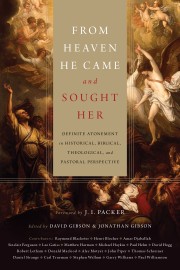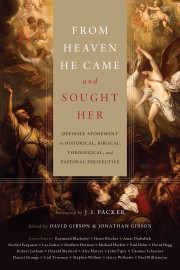Author Interview Part 1
What did Christ intend to accomplish by his cross? One would think that by this point in history such an easy question would be easy. But it is a question that in some ways divides. Did Christ die intending to save his elect only? Or did he have a wider purpose?
We might also think that by this point in history this book has already been written! But in fact Gibson and Gibson here make a significant contribution. Indeed, it is something of a landmark event, as D.A. Carson remarks in his endorsement:
“Whatever side you hold in this debate, henceforth you dare not venture into the discussion without thoughtfully reading this book, which, mercifully, makes argument by stereotype and reductionism a great deal more difficult. Above all, this book will elicit adoration as its readers ponder afresh what Jesus achieved on the cross.”
Today we are pleased to interview David Gibson (PhD, University of Aberdeen; minister of Trinity Church in Aberdeen, Scotland) and Jonathan Gibson (PhD, Cambridge University), editors of the recent and important book, From Heaven He Came and Sought Her: Definite Atonement in Historical, Biblical, Theological, and Pastoral Perspective (Crossway).
Books At a Glance (Fred Zaspel):
First, a mere curiosity question that we’re sure many of our readers will have. David and Jonathan Gibson – are you brothers? Otherwise related?
Gibsons:
Yes, we are brothers, though one of us is better looking and more clever than the other one.
 Books At a Glance:
Books At a Glance:
Please tell us something of your own backgrounds. Is the position reflected in this book part of your own Christian heritage? And why did you decide to pursue such an ambitious project centered around this particular doctrine? And what makes this subject such an important one?
Gibsons:
We are sons of missionary parents, raised in a loving Christian home, where we were faithfully taught the gospel from our earliest days. However, our upbringing was not in the Reformed Christian tradition, so our belief in definite atonement was a journey for both of us, and we both arrived at it via different paths. David studied theology at the universities of Nottingham and King’s College London, before specializing in the history of biblical interpretation for his doctoral studies in Aberdeen; Jonathan studied at Moore Theological College, Sydney, and then completed his doctorate in Hebrew studies at Cambridge University. By separate routes, and at different times, we have come to see in the Scriptures the glorious truth of Christ’s death for his people, the church, which at the same time does not contradict his mandate to proclaim the gospel to the world.
Why did we pursue an ambitious volume on definite atonement? A number of years ago we noticed that since John Owen’s classic work The Death of Death (1647) there had not been a comprehensive and contemporary treatment of the doctrine from all the theological disciplines: historical, biblical, theological, and pastoral. When we read about the doctrine in contemporary works, we found that some of the traditional “Calvinistic” approaches were either too hasty in trying to prove the doctrine, or they were more biblicist than biblical and failed to see the doctrine as a biblico-systematic conclusion reached on the other side of a comprehensive synthesis of related texts and doctrines. There were also a lot of caricatures of the doctrine from opponents, which revealed that it had not been properly understood.
So we realised that there was a need for an in-depth, comprehensive, but careful treatment of definite atonement, one which looked at the doctrine from a number of perspectives. We wanted a volume written at the highest academic level, so we assembled a line up of leading scholars in the evangelical world. We also wanted the book to have a warmth and winsomeness that might diffuse some of the heat associated with definite atonement and allow the glory of this truth to sparkle and shine. We didn’t want to win an argument; we wanted to help the convinced and win the unconvinced.
We chose to dedicate 6 years of our time to this big project because we believe that, while definite atonement does not say everything there is to say about Christ’s death, it does go to the heart of the meaning of his death. The ambitious claim of our book is that, penal substitutionary atonement, rightly understood, naturally entails definite atonement.
Books At a Glance:
Since there is such misunderstanding, please give us an example of how this doctrine can be stated most concisely and most helpfully.
Gibsons:
The doctrine of definite atonement states that, in the death of Jesus Christ, the triune God intended to achieve the redemption of every person given to the Son by the Father in eternity past, and to apply the accomplishments of his sacrifice to each of them by the Spirit. In a nutshell: the death of Christ was intended to win the salvation of God’s people alone; and not only was it intended to do that but it actually achieved it as well. Jesus will be true to his name: he will save his people from their sins. In other words, we believe that everyone for whom Christ died will be saved—but we’re not universalists!
Books At a Glance:
In what ways is this doctrine most frequently misunderstood?
Gibsons:
The biggest misconception is probably connected to the foreboding landscape that comes into view when the doctrine is referred to as “limited” atonement. When cast this way, either God’s love is portrayed as limited (so Mark Driscoll and Gerry Breshears in Death by Love: Letters from the Cross), or the emphasis falls on the number of the redeemed being limited, or the gospel’s universal offer is viewed as limited. The biggest misunderstanding might be that “limited” atonement seems to proclaim what God doesn’t do, when in fact it should spotlight what he does do: God saves sinners.
But then again, from a different angle it could be argued that many who hold to penal substitution without holding to definite atonement fail to see how denying the atonement’s definite intent redraws its penal nature. Our book contends that believing in penal substitution while rejecting definite atonement is a common misunderstanding of penal substitution.
Books At a Glance:
Please explain how this doctrine is so tightly tied to the doctrine of substitution.
Gibsons:
In the book, Garry Williams argues that the Old and New Testaments describe atonement made for the specific sins of specific people. Thus the specificity and particularity of Christ’s death occurs, not at the point of application, but at the point of intent and accomplishment. This not only precludes any account of the atonement that would describe sin or punishment indefinitely, but it also spotlights the illegitimacy of a double payment for these sins. As Williams argues, “So long as God has identified this punishment for these sins, then he cannot punish them again. An indefinite atonement must either embrace universalism or it must contradict the biblical doctrine of penal substitution.”
Books At a Glance:
It has often been said by Calvinists that the death of Christ is sufficient for all but efficacious for the elect. What do you think of this summary statement? Is it accurate? Is it adequate? Useful? Precise? Open to misunderstanding?
Gibsons:
The maxim “sufficient for all, efficient for the elect” was first coined by Peter Lombard in the 12th century. It is often used by some as a summary of the classical Reformed position on the atonement. This, however, is inaccurate, since, as a statement concerning the doctrine of atonement, it can be affirmed by all sides. Arminians have no problem with it because they, along with Amyraldians and Hypothetical Universalists, generally interpret it to mean that Christ’s death is sufficient for all because an atonement was paid for all, according to the will of God, but it is efficient only for those who believe. In other words: universal atonement by Christ on the cross, limited application at the point of faith. John Owen, among others, interpreted it differently: Christ’s death is sufficient for all because it has an intrinsic value irrespective of the number of those for whom he died, but it was intended solely for the elect and therefore it was efficient for them alone. This does not mean that the atonement was insufficient for the non-elect because it wasn’t intended for them. Owen spoke of Christ’s death being sufficient for “the whole world.” If Christ had died for more people than the elect, he would not have suffered any more. So, Christ’s death was of infinite worth (“sufficient for all”), but it was intended only for the elect (“efficient for some”).
Distinguishing the sufficiency and intentionality of Christ’s atoning death is key, and the distinction is clearly present in the Synod of Dort. Compare these two statements:
“And, whereas many who are called by the gospel do not repent nor believe in Christ, but perish in unbelief; this is not owing to any defect or insufficiency in the sacrifice offered by Christ upon the cross, but is wholly to be imputed to themselves.” (Second Head, Article 6)
“For this was the most free purpose and most gracious will and intention of God the Father, that the life-giving and saving efficacy of the most precious death of his Son should extend to all the elect, for bestowing upon them alone justifying faith, thereby to bring them unfailingly to salvation; that is, God willed that Christ through the blood of the cross (by which he confirmed the new covenant) should effectually redeem out of every people, tribe, nation, and language, all those, and those only, who were from eternity chosen for salvation and given to him by the Father; that he should bestow upon them faith (which, together with all the other saving gifts of the Holy Spirit, he acquired for them by his death); that he should purify them by his blood from all sins, both original and actual, whether committed after or before believing; and having faithfully protected them even to the end, should finally establish them glorious before him, free from every spot and blemish.” (Second Head, Article 8)
The first article makes clear that there was nothing in the atonement itself that lacked sufficiency to save sinners. If someone did not believe, it was not due to any deficiency in Christ’s death. The second article indicates that if someone did believe, it is because God had so intended it, and such faith was itself acquired by Christ’s own death. This is why it is best to speak of the intent of the atonement rather than its extent. The question is, to quote Louis Berkhof, “Did the Father in sending Christ, and did Christ in coming into the world, to make atonement for sin, do this with the design or for the purpose of saving only the elect or all men? That is the question, and that only is the question.” Focusing on the intent rather than the extent of the atonement also steers us away from trying to “quantify” the atonement in commercial or mathematical terms and instead brings the purposes of the triune God front and center.
Editor:
Click here to see Part 2 of our interview with the Gibson brothers, where they address for us questions regarding the devotional value of definite atonement and advice for those who preach and discuss this doctrine with others.

